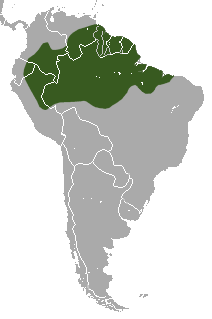Linnaeus's two-toed sloth
| Linnaeus's two-toed sloth[1] | |
|---|---|

| |
| Scientific classification | |
| Domain: | Eukaryota |
| Kingdom: | Animalia |
| Phylum: | Chordata |
| Class: | Mammalia |
| Order: | Pilosa |
| Family: | Choloepodidae |
| Genus: | Choloepus |
| Species: | C. didactylus
|
| Binomial name | |
| Choloepus didactylus | |

| |
| Linnaeus's two-toed sloth range | |
| Synonyms | |
|
Bradypus didactylus Linnaeus, 1758 | |
Linnaeus's two-toed sloth (Choloepus didactylus), also known as the southern two-toed sloth, unau, or Linne's two-toed sloth is a species of sloth from South America, found in Venezuela, Suriname, Guyana, French Guiana, Colombia, Ecuador, Peru, and Brazil north of the Amazon River. There is now evidence suggesting the species' range expands into Bolivia.[4] It's the largest extant sloth species.[5]
Description
Males and females are the same size, growing to lengths of approximately 21” to 35” (not including the length of the tail) and weigh 9 to 24 pounds.[5] Their fur color ranges from a brownish yellow to a pale tone of brown, however, in the wild their fur sometimes has a green hue from algae that grows on their fur during the rainy season.[5] Their belly fur is slightly lighter in color than the body and they have no undercoat.[5] The belly hair is parted along the midline and flows towards the animals back (spine), the opposite direction that fur flows on most other mammals.[5] Young sloths tend to have softer and darker fur than adults.[5]
Phylogeny
Sloths belong to the order Pilosa, which also includes anteaters. They belong to the super order Xenarthra, which includes the Cingulata. Xenarthra are edentate or toothless. They lack incisors and have a large reduction in number of teeth with only four to five sets remaining including canines.[6]
Modern sloths are divided into two families based on the number of toes on their front feet,
Morphology
Choloepus didactylus are larger than three-toed sloths. They have longer hair, bigger eyes, and their back and front legs are more equal in length.[8] Their ears, hind feet and head are generally larger than Bradypodidae. They do however have a shorter tail.[9] Their shoulder height, the height from the shoulder blade to the tips of the claw is longer than three-toed sloths, indicating longer arms.[9]
The species has relatively few teeth; it has four to five sets including canines and lacks incisors. Molars are indistinguishable from premolars.[5] The teeth are rootless[5] and lack enamel, consisting only of two layers ever-growing dentin.[6] Supernumerary teeth have occasionally been observed, but this has been reported in almost all mammalian orders.[6]
Ecology
C. didactylus is a solitary,
Two-toed sloths live in ever-wet tropical rainforests that are hot and humid. They tend to live in areas where there is a lot of vine growth so they can easily travel from tree to tree in the canopies of the forests.[7] They mainly eat leaves, but there is lacking data on the extent of their diet due to their nocturnal lifestyle and camouflage.[7]
C. didactylus, similar to other sloth species, have a low rate of metabolism, food intake, and defecation, despite their relatively large body mass and their high volumes of methane production. They retain their digested material for long periods of time, due to a combination of their low defecation rates and large digestive systems.[10] This long digestion period appears to cause the sloths’ high volumes of methane production, more than most other, similar herbivores.[10] These high methane levels may also be the result of high formate levels in their digested material.[11]
See also
- OCLC 44179508.
References
- OCLC 62265494.
- . Retrieved 19 November 2021.
- ^ Linnæus, Carl (1758). Systema naturæ per regna tria naturæ, secundum classes, ordines, genera, species, cum characteribus, differentiis, synonymis, locis. Tomus I (in Latin) (10th ed.). Holmiæ: Laurentius Salvius. p. 35. Retrieved 23 November 2012.
- ISSN 1413-4411.
- ^ a b c d e f g h "Choloepus didactylus (Linnaeus, 1758)". www.gbif.org. Retrieved 2023-09-19.
- ^ a b c McAfee, Robert K.; Naples, Virginia L. (2012-01-01). "NOTICE ON THE OCCURRENCE OF SUPERNUMERARY TEETH IN THE TWO-TOED SLOTHS Choloepus didactylus AND C. hoffmanni". Mastozoología Neotropical. Retrieved 2015-11-20.
- ^ a b c d e Adam, Peter J. (December 1999). "Mammalian Species Choloepus didactylus". American Society of Mammalogists.
- ^ Stewart, Melissa (November–December 2004). "At the Zoo: Slow and Steady Sloths". Zoogoer. Smithsonian Institution. Archived from the original on 7 June 2011. Retrieved 23 November 2012.
- ^ ISSN 1469-7998.
- ^ PMID 26122705.
- PMID 26271635.
Gallery
-
1883 painting
-
Choelopus didactylus at Buffalo Zoo
-
Sloth & baby, caught atLeticia, Colombia




